Ohio was home to our Nation’s first major meat packing city, to a beef marketing company that caused the vast majority of U.S. cattle to become black-hided and is now where the best method of preparing the one time underutilized (think sustainable Agriculture gains) beef brisket was developed.
Start with a USDA Choice quality grade or higher packer (untrimmed) boneless brisket. Briskets with the sternum removed are the retail norm.
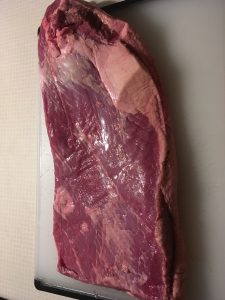
I was looking for a somewhat larger one, but this 10.21 pound packer brisket from Gordon Food Service (GFS) at $3.29 per pound had to do because they were in short supply at the time of my visit. I merely scraped the exposed lean side because there was not enough fat or other objectionable material left attached for me to have to knife trim. I didn’t even freshen (trim back) exposed lean that had become discolored from harvest plant antimicrobial treatments of steam cabinet jets or organic acid sprays.
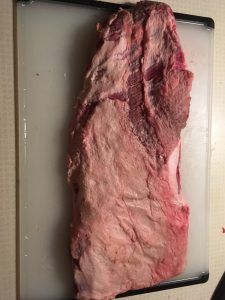
Subcutaneous and deckle fat were trimmed down to 1/8 of an inch thick. That fat, plus an estimate of heavy seam fat between the point and flat totaled 2.21 pounds. Keeping with a widely used BBQ restaurant practice, soft pre-pump brisket trim fat lends itself very well to in-house sausage production. As listed above, the purchase weight of this brisket was 10.21 pounds; so the trimmed starting-raw brisket was 8 pounds. Therefore, the cost of starting closely trimmed brisket went up to $4.20 per pound.

Calculating from that 8 pound weight, I mixed a pumping solution containing 4 cups of cold water, 4 tablespoons of purified salt and 3 teaspoons of roast sodium phosphate (Amesphos). Dissolve the sodium phosphate ahead of the salt. The tall drinking glass and tall shot glass both help facilitate filling the hand brine pump. Pump as much brine into the brisket that you can and at as many different injection sites as you can. When pumping a roast using this common style of 10 hole blunt-ended spray needle, don’t try to push through subcutaneous fat layers and the underlying muscle cover silver-skin. Instead. access the cut from the exposed lean side and edges.
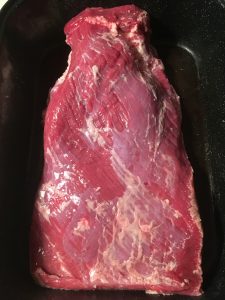
Here, the trimmed and fully pumped intact brisket sits in the large rectangular roasting pan, where it was pumped.
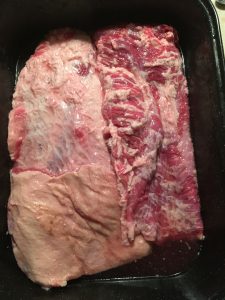
Pumping expands everything; making it easier to do a good job of seaming the point off the flat. Follow the point tightly when seaming so that the point’s webbed lean & fat is exposed. Then, fat-down the flat cut’s seam fat in the newly exposed area to 1/8 of an inch thick.
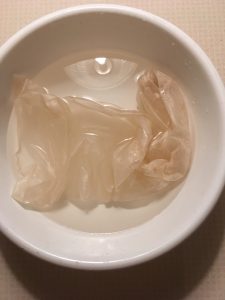
Soak one semipermeable fibrous, boneless ham casing in warm water. Dissolve 1 teaspoon of Prague powder #1 into the soak water. You don’t have to, but I turned the casing inside out during soaking. Of course, if turned inside out, the casing has to be turned back prior to stuffing it. Soak the casing for about 1/2 hour or so before stuffing it.
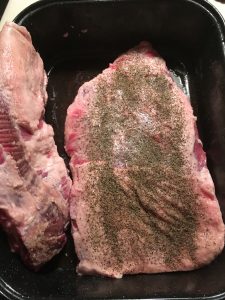
Splash a little bit of the casing soak water onto the fat side of both cuts and spread it around by hand. Next, somewhat liberally sprinkle coarse ground black pepper on the fat side of the flat.
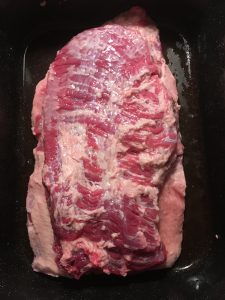
Place the fat sides of both cuts together; with the thickest end of one cut contacting the thinnest end of the other.
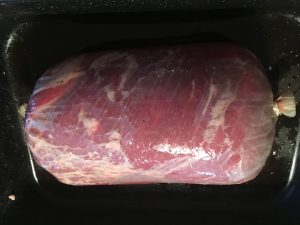
Hand stuff the laid together brisket cuts into the casing, tie the open end shut with cotton butcher’s twine or clip it shut using hog-ring pliers and then cut off any excess casing with kitchen shears. I cut off about 5 inches of extra casing after stuffing this moderate size brisket. There was still some room left in the ham casing after stuffing; so I estimate that one could start with up to about a 14 pound packer brisket (depending upon fat trim amounts), when using fibrous ham casings.
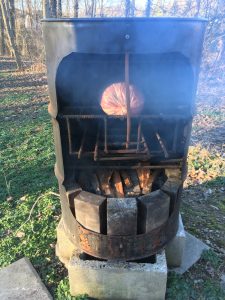
Cased brisket was placed point side down on the Wolfer smoke-cooker’s rebar rack; so the web-fat of the point will cook more than the flat – by way of heat conduction through the metal rack that is welded to a heavy metal fuel/flue pipe that is located at the rear of the smoke-cooker. If one has a restaurant size oven that’s big enough for finish steam-cooking, up to 5 cased briskets at a time can go through the smoke-cooking phase in a Wolfer Smoke-Cooker.
To fire-off the cook, two full charcoal chimneys of standard briquettes were partially lit, then thick pieces of cherry (a suitable hardwood) kindling were laid on top of the charcoal. The cast iron water pan is full and the copper water refill tube is in place. It’s then time to put the shroud in place for the duration of the smoke-cooking phase.
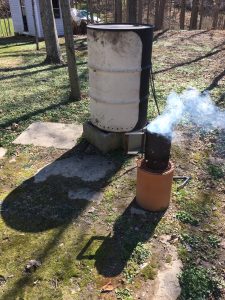
About every two hours, during the smoke-cooking phase, 2/3 thirds of a charcoal chimney of partially lit briquettes has to be added down the smoke-cooker’s flue/fuel pipe, in order to maintain an overall 205 to 245F cooking range. The water pan is topped-off whenever briquettes are added. Ash comes out of the flue/fuel pipe whenever the water pan overflows; telling one to stop adding water down the copper water fill tube.

After smoke-cooking for 8 hours in the 225F range, the brisket was taken inside to finish in a gas oven. The internal roast temperature was just above 150F at that time.

Soot was rinsed off the casing exterior, casing was striped, and brisket was placed point side-down on a rack in a large rectangular roasting pan. The roasting pan was then covered with its lid and placed in a 250F oven for 2 hours; at which time the brisket roast reached just over 200F internal. Warning: Once the brisket gets to cooking in the oven you will most likely be drooling for a few hours, until it’s time to eat.
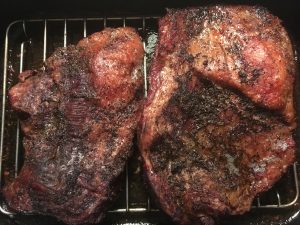
The two different brisket cuts were then separated, the fat sides were turned up and placed under the oven broiler for around 10 minutes; until their peppered fat browned up nicely. At the time that I stuffed the brisket into the casing I was concerned that they might cook into a curved shape, but as you can see they flattened out rather nicely.
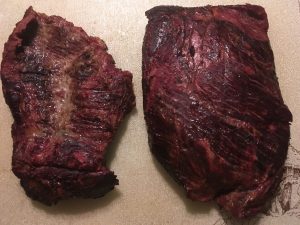
This is the lean side of both cuts at the end of cooking. I realize that a lot of people have grown used to eating a charred crust, but to me this is practice provides optimal color and beef flavor.
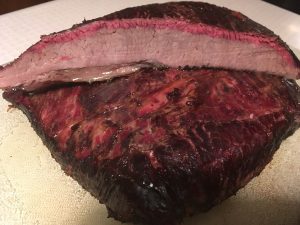
The flat cut in half across the grain.

The point cut in half.
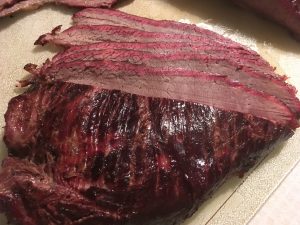
Warm, very moist and tug test tender flat slices.
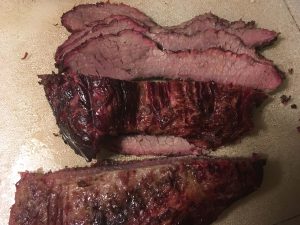
Warm and extra delicious point slices.
There is a good bit of science and practical know-how behind this brisket process. I will gladly provide further explanation of any part of it.
Eat wisely and well my friends. I don’t know that brisket is really worth it, but “if your going to play the game you got to learn to play it right” (use an optimal preparation technique). There’s no reason to over spend on smoke-cooking units, spice rubs. cooking accessory gadgets, supplies or other barbecue related items; the brisket itself has now moved from being an underutilized inexpensive cut to being relatively costly. You won’t hear that kind of talk anywhere else because others are either trying to sell you something themselves or are trying to make money off advertising sponsors who are trying to sell you things that you don’t really need. Even University Extension offices have to be mindful not to offend potential money donors, business or private.
